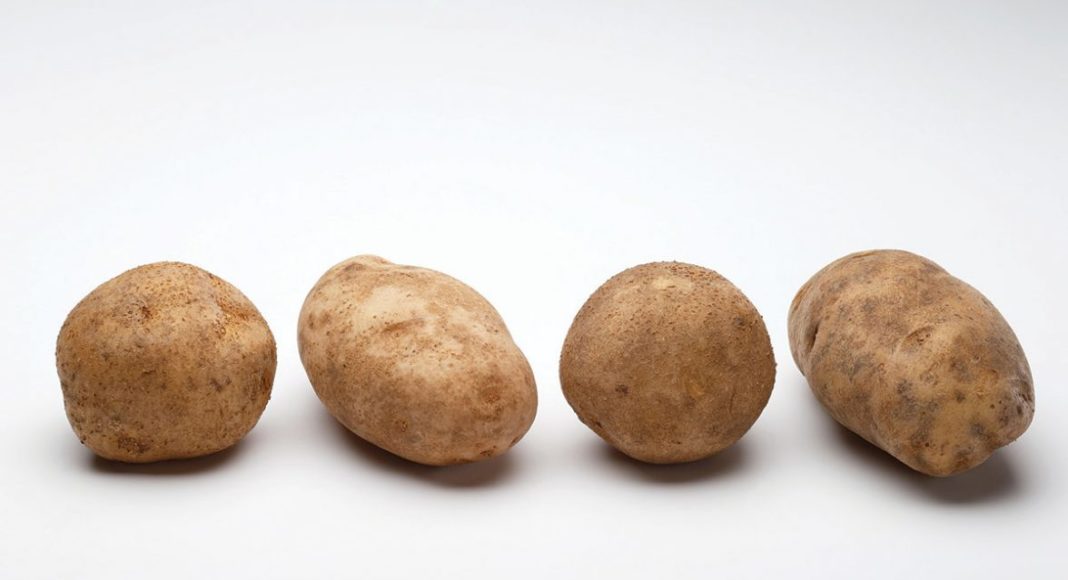[deck]J.R. Simplot Company says it’s developed a better potato. What are the benefits for farmers, processors and consumers?[/deck]
Following United States Department of Agriculture approval of Innate potatoes in November, J.R. Simplot Company expects to receive approval from the U.S. Food and Drug Administration for its Innate product within a few months, the final hurdle for commercially producing the genetically modified potatoes in the United States. The company anticipates similar approval by Health Canada in early 2015, clearing the way for Innate in this country.
Doug Cole, Simplot’s director of company marketing and communications, says Innate potatoes have been a long time in the making.
“Since 2011 we have conducted over 140 test trials in main potato growing regions in both countries,” Cole says. “Innate potatoes were a vision of [Simplot Chairman] Scott Simplot over a decade ago and were developed simply to produce a better overall quality potato for growers, processors and consumers.”
Cole adds that Innate potatoes address a number of major concerns facing the North American potato industry, including cold storage and bruising issues and late blight disease. The second generation of the product, he says, will offer no browning and reduced blackspot or bruising, as well as resistance to late blight.
The potatoes also contain less acrylamide, which has come under scrutiny in recent years as a possible cancer-causing agent in some foods. “Innate potatoes when fried, produce less acrylamide, a chemical that naturally forms in certain foods during processing or cooking at a high temperature,” Cole says.
He adds the company’s plant sciences team developed Innate technology by enhancing and suppressing specific potato traits to provide better yield, storage, taste and nutrition. Innate potatoes, Cole says, pose no harm to other plant species and grow just like conventional potatoes.
“It is a stacked-trait, using cultivated or wild genes,” explains Cole. “Through this technology, we were able to silence a specific gene … such as sugar build-up during cold storage which also helps to reduce bruising.”
Health Benefits
Joe Guenthner, a professor emeritus of agricultural economics at the University of Idaho, maintains Innate potatoes are a sustainable, healthy alternative to conventionally bred potatoes and applauds that they’re produced by manipulating potato genes and that foreign genes aren’t added in the breeding process.
“I call this ‘Green GM,’” Guenthner says. “Since some anti-GM activists have defined GM as transferring genetic material across species, I expect some of them will be supportive of ‘Green GM’ products.”

Guenthner maintains Innate’s health benefits will make the potatoes particularly marketable in the fresh, fresh-cut and potato chip markets.
“For example, Innate potatoes have up to 70 per cent less acrylamide — a naturally occurring chemical compound found in most foods cooked at high temperatures,” he says. “In addition, Innate potatoes bruise about 40 per cent less and will not show black spots or turn brown when cut. For this reason, they will provide a convenient, higher quality option for consumers.”
Guenthner says that growing Innate potatoes will enable producers to sell up to 15 per cent more of their crop, resulting in increased grower revenue due to higher marketable yields, better quality and less storage shrinkage.
“Simplot’s second generation of Innate potatoes will have North American blight resistance and [enhanced] cold storage capability, which will reduce the use of both fungicides and sprout suppressants,” he says. “Production costs per hundredweight will also be lower due to the use of fewer chemical products.”
Benoit Bizimungu, potato breeder and gene resources curator with Agriculture and Agri-Food Canada’s Potato Research Centre in Fredericton, N.B., believes Innate’s added traits represent breeding solutions that in traditional breeding would have taken a much longer time to accomplish.
“This breeding technology allows researchers to find solutions to established varieties by specifically targeting and modifying individual traits during a much shorter time-frame versus traditional methods,” explains Bizimungu. “In that regard, this technology is complementary to traditional breeding efforts, using more precise tools to target specific traits while preserving the essential nature of the variety.”

Marketing Outlook
Simplot is confidant consumers will buy into Innate as an alternative to conventionally bred potatoes as they learn about its benefits.
According to Guenthner, Innate could save an estimated 400 million pounds of landfill potato waste from restaurants and supermarkets. Other possible environmental benefits cited by Simplot include a 60-million pound reduction in carbon dioxide emissions, 6.7 billion fewer gallons of water used, and 800,000 fewer acres sprayed with pesticides.
Simplot acknowledges that public acceptance will be key to Innate’s success in the marketplace. Cole says there are plans to market Innate potatoes based on their high quality for growers and processors and health benefits for consumers.
While the second generation of Innate potato is specifically a Russet Burbank variety, several additional varieties which include Ranger Russet, Atlantic and Snowden will be submitted for USDA and USFDA approval later this year. Simplot expects to license the potatoes to select partners for test markets in 2015.
“We are planning for roughly 2,000 acres of Innate to be planted in 2015 and ramp that up in 2016,” Cole says. “During this time we also plan to execute our marketing strategy to help consumers understand the added benefits of this new technology and its health benefits.”
Guenthner believes Innate potatoes will succeed in Canada “because they benefit growers, consumers and the environment.
“Once consumers recognize that the potatoes go beyond what is possible within the constraints of conventional breeding, while staying completely in the potato genetic family, I believe they will be more likely to accept them,” he says. “Canada has always been progressive in understanding better, more effective crops which is why they have thriving GM domestic and export markets.”











